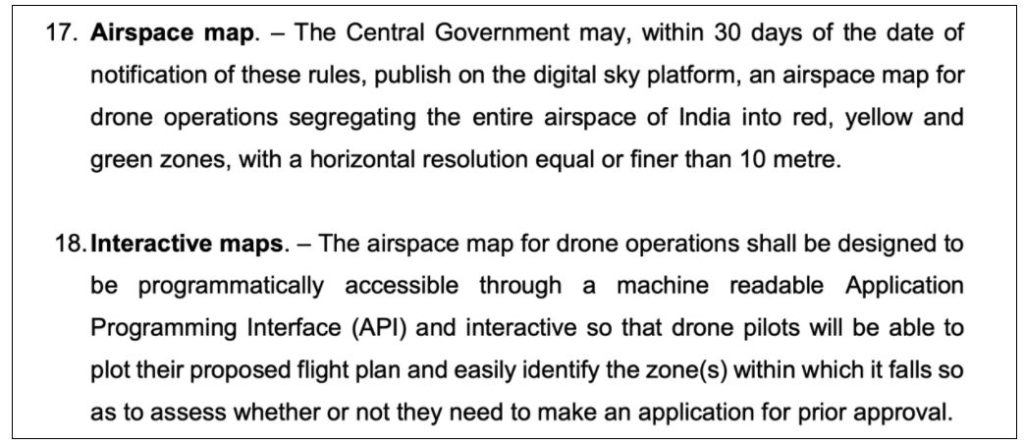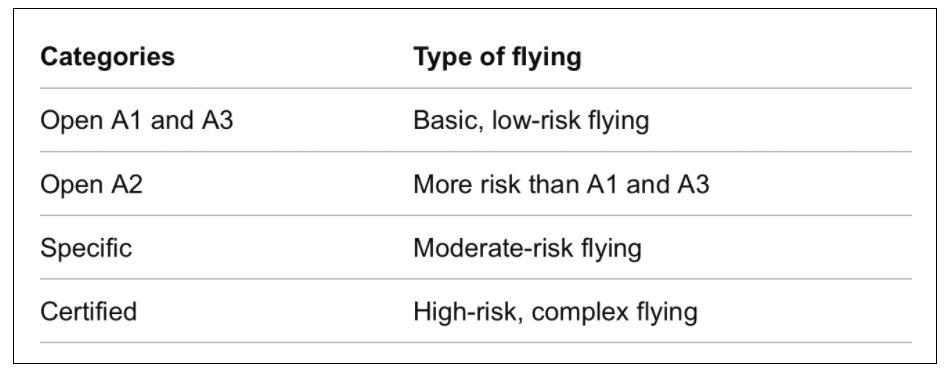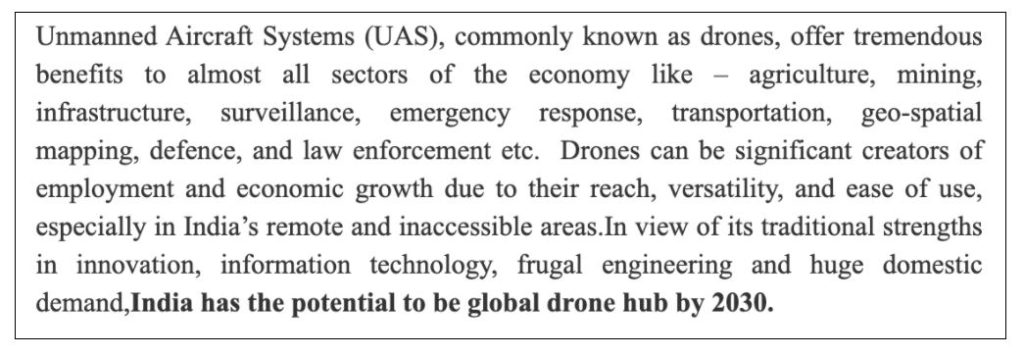The government has recently notified the new ‘Drone Rules, 2021’ to simplify the process of registration, granting of permission & required licenses. The rules are aimed at encouraging the usage of drones for economic benefit across many sectors. But how do these rules compare with those in countries like USA & UK?
The Ministry of Civil Aviation (MoCA) has recently notified the Drone Rules, 2021. These new rules are considered to be more liberalized and replace the earlier rules notified in March-2021 (UAS Rules, 2021). As per the statement issued by the government, the earlier version of the rules i.e., UAS Rules, 2021 were perceived to be restrictive by academics, industry & various other stakeholders, involving a lot of paperwork & permissions to operate Unmanned Aircraft Systems (UAS), also referred to as Drones. Considering the feedback and the potential of drones to contribute to the varied sectors of the economy, the Government of India (GoI) has decided to take a more liberalized approach.

The government envisages that encouragement to the usage of drones can aid in economic growth in view of the reach & versatility they offer in reaching out to remote & inaccessible areas.
While there are diverse benefits that drones offer and a more liberalized approach can help in encouraging their usage, there are potential challenges and risks that drones pose. The recent attack on Jammu Air Force Station using Unmanned Ariel Vehicles/Drones is an example of the harmful use of drones. Furthermore, there are concerns around unregulated usage of drones on the environment which impacts the wildlife, particularly the avian species.
In this context, we look at the new ‘Drone rules’ notified by GOI and review the rules relating to Unmanned Ariel vehicles in other countries.
Definition & Classification
‘Drone Rules 2021’, define a drone as an aircraft that can operate autonomously or can be operated remotely without a pilot on board.’
Drones are classified into five types based on their weight (including maximum payload)
– Nano drone: Less than or equal to 250 gms.
– Micro drone: Greater than 250 gms, less than or equal to 2 kgs.
– Small drone: Greater than 2 Kg and less than or equal to 25 kgs,
– Middle drone: Greater than 25 kgs and less than or equal to 150 kg
– Large drone: Greater than 150 kgs.
Significant relaxations on registration & approvals
Tweeting about the new Drone Rules, Prime Minister Narendra Modi stated that the new rules are based on the premise of trust & self-certification and that there is a significant reduction in the approvals, compliance & entry-barriers.
This is evident from the relaxations offered as a part of the new rules. Few of the important relaxations include:
- The total number of forms that are required to be filled were reduced to 5 from the earlier 25.
- The different types of fees required to be paid were also significantly reduced from 72 to just 4.
- Approvals relating to – Unique authorization number, unique prototype identification number, certificate of manufacturing and airworthiness, certificate of conformance, certificate of maintenance, import clearance, operator permits, authorization of R&D organization, remote pilot instructor authorization, drone port authorization, student remote pilot license, etc. are now abolished.
- Earlier, the fees were commensurate with the size of the drone. This has been now delinked and the overall fee has been reduced to Rs.100 as a standard across all the drones, irrespective of the size.
- No Pilot license is needed for micro drones used for non-commercial purposes and Nano drones.
- License is also not needed for use by R&D organizations. Further, there would be no restrictions on drone operations by foreign-owned companies that are registered in India.
- Earlier a security clearance was necessary for issuance of registration or license, now this is done away with.
- There is also an increase in the coverage to include up to 500 kgs from the earlier 300 kgs. This would also include drone taxis.
The government envisages the development of Digital Sky platform & Drone corridor
Among the other key provisions of the ‘Drone rules, 2021’ is the government’s proposal to develop the Digital Sky platform. It is proposed to be a single-window platform for all the required approvals & clearances.
The Digital Sky platform will have an interactive airspace map that would divide the country into – Green, Yellow & Red zones. The demarcation of these zones would help the drone operators to understand where they can or cannot fly their drones. This platform would provide a secure and scalable platform that will support drone technology frameworks, that are designed to enable flight permission digitally and manage unmanned aircraft operations & traffic.

As part of the liberalized regulations, the government has provided relaxation within these zones. The extant of airport perimeter is reduced to 12 km from the earlier 45 km. As per the new rules, there is no need for flight permissions to fly up to 400 feet in green zones and up to 200 feet in the area between 8-12 km from the airport perimeter.
Apart from the development of the Digital Sky Platform, the Ministry of Civil Aviation also proposes to facilitate the development of Drone corridors. These would be used for cargo deliveries. There is a proposal to set up a Drone promotion council that aims to facilitate a business-friendly regulatory regime.
Among the other important provisions is the provision of safety features – real-time tracking beacon, geo-fencing, etc. The industry would be given a 6-month lead time for compliance before these are notified.
Registration of Drones is compulsory in the USA
Some of the developed countries are ahead in recognizing the increased use of drones and have laid down rules & regulations that monitor the usage of these unmanned aircraft and encouraging their usage within certain restrictions.
United States of America (USA)
As per the regulations of the USA’s Federal Aviation Administration (FAA), it is legal to operate Unmanned Aircraft Systems in the USA. However, every drone is compulsorily required to be registered. The registration is valid for up to a period of three years and requires to be renewed on expiry.
The rules for operating a drone vary based on the type of drone user. As per FAA, drone users are categorized into:
- Recreational user
- Certified remote pilot or Commercial operator
- Public Safety or government user
- Education user.
Prior to the application for drone registration, drone users are required to pass certain tests. In the case of recreational users, they are required to undergo – The Recreational UAS Safety Test (TRUST). In the case of a certified user, they are required to clear FAA’s Knowledge Test.
Regulations regarding the extent of the flight, the perimeter of air space, etc. vary as per the type of user and according to the specific State. However, there are restrictions on the usage of drones in Security sensitive air spaces, including – Military bases, national landmarks, critical infrastructure, etc.
Similar to the proposed Digital Sky platform, the USA already has an App – B4UFLY mobile app, which provides interactive maps of fly zones and restricted zones.
United Kingdom (UK)
The Civil Aviation Authority in the UK lays down the rules & procedures regarding the operation of drones & unmanned air crafts. As per the ‘Drone and Model Aircraft Code’, it is illegal to fly a drone without having the required IDs. In the UK, two types of IDs are required to fly drones– Flyer ID (indicating that one has passed the basic flying test) & Operator ID (which is required to be labeled on the drone). Further, the rules also lay down the category of the drone. The rules & regulations regarding – where to fly, the proximity to crowds, etc. vary based on the category.

As per the restrictions in the UK, the drone should not fly more than 120 meters from the closest point on earth. Even in the case of flying from an elevated surface like hills & mountains, care needs to be taken the drone is not at an elevation of more than 120 m from the closest point on the earth’s surface. Furthermore, there needs to be a minimum horizontal distance of 50m between people & the drones. A perimeter of 150 m around recreational, residential, commercial & industrial areas is considered as no-fly zones, and an area of around 5 Kms around airports & airfields is considered as no-fly zones. Specific authorizations are required if one has to fly beyond the specified zone.
European Union (EU)
The EU has also devised its own set of rules for the operation of drones in EU countries. As per these rules passed by European Union Aviation Safety Agency (EASA), there are three categories of operators & drones.

As per EU regulations, most recreational drones are categorized under the Low-risk category. The drones under this category are further divided into three different types.

EU mandates that all Drone operators register with their respective country of residence. Across the USA, UK & EU countries, the vertical limit for flying a drone is 120 m (400 ft) above the earth’s surface.
While the liberalized rules are encouraging, need for proper oversight on ownership & usage
The new Drone rules, 2021 are a welcome step in encouraging the usage of drones in the country. The government proceeding with a new set of liberal rules despite a first-of-its-kind drone attack in India in late June 2021, indicates the intent of the government in this direction.
In his tweet, the Prime Minister highlighted the expected benefits of these new rules. The press release by the Ministry of Civil Aviation, states the different sectors where drones can be useful and highlights the proposed significance in economic growth.

As per BIS Research, the Global Drone market is expected to touch $ 28.47 billion this year of which India’s share could be around 4.25% i.e. around $ 1.21 billion, indicating a potential market space that the country can take advantage of with the more liberalized rules.
However, the recent drone attack and further sightings of drones highlight the potential risk which the drones carry in the sensitive zones. India’s investment in counter drones can offer a solution to counter any drone attacks while continuing with liberal rules in encouraging the usage of drones in other areas.
A significant aspect observed in the rules of other countries is the compulsory registration of the drones and the certifications for both the usage & for the operators. While the Indian rules have been relaxed a bit regarding the registrations and authorizations, the mode & nature of the registration mechanism, certification & licensing for remote pilots, devices, etc. remains to be seen.
Featured Image: India’s Drone Rules


